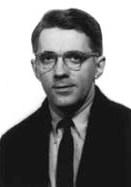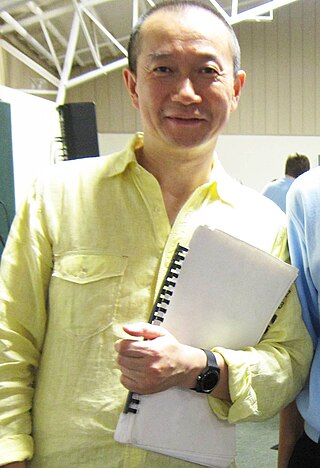
David Eugene Tudor was an American pianist and composer of experimental music.

John Milton Cage Jr. was an American composer and music theorist. A pioneer of indeterminacy in music, electroacoustic music, and non-standard use of musical instruments, Cage was one of the leading figures of the post-war avant-garde. Critics have lauded him as one of the most influential composers of the 20th century. He was also instrumental in the development of modern dance, mostly through his association with choreographer Merce Cunningham, who was also Cage's romantic partner for most of their lives.

Alvin Augustus Lucier Jr. was an American composer of experimental music and sound installations that explore acoustic phenomena and auditory perception. A long-time music professor at Wesleyan University in Middletown, Connecticut, Lucier was a member of the influential Sonic Arts Union, which included Robert Ashley, David Behrman, and Gordon Mumma. Much of his work is influenced by science and explores the physical properties of sound itself: resonance of spaces, phase interference between closely tuned pitches, and the transmission of sound through physical media.

Mercier Philip "Merce" Cunningham was an American dancer and choreographer who was at the forefront of American modern dance for more than 50 years. He frequently collaborated with artists of other disciplines, including musicians John Cage, David Tudor, Brian Eno, and graphic artists Robert Rauschenberg, Bruce Nauman, Andy Warhol, Roy Lichtenstein, Frank Stella, and Jasper Johns; and fashion designer Rei Kawakubo. Works that he produced with these artists had a profound impact on avant-garde art beyond the world of dance.
Larry Don Austin was an American composer noted for his electronic and computer music works. He was a co-founder and editor of the avant-garde music periodical Source: Music of the Avant Garde. Austin gained additional international recognition when he realized a completion of Charles Ives's Universe Symphony. Austin served as the president of the International Computer Music Association (ICMA) from 1990 to 1994 and served on the board of directors of the ICMA from 1984 to 1988 and from 1990 to 1998.

Tan Dun is a Chinese-born American composer and conductor. A leading figure of contemporary classical music, he draws from a variety of Western and Chinese influences, a dichotomy which has shaped much of his life and music. Having collaborated with leading orchestras around the world, Tan is the recipient of numerous awards, including a Grawemeyer Award for his opera Marco Polo (1996) and both an Academy Award and Grammy Award for his film score in Ang Lee's Crouching Tiger, Hidden Dragon (2000). His oeuvre as a whole includes operas, orchestral, vocal, chamber, solo and film scores, as well as genres that Tan terms "organic music" and "music ritual."
Daniel James Wolf is an American composer.
Gordon Mumma is an American composer. He is known most for his work with electronics, many devices of which he builds himself, and for his performances on horn.

Le piège de Méduse is a short play of which Erik Satie wrote both the text and the incidental music.

Chantal Francesca Passamonte, known professionally as Mira Calix, was a South African-born, British-based audio and visual artist and musician signed to Warp Records.
Takehisa Kosugi was a Japanese composer, violinist and artist associated with the Fluxus movement.

Stephen Rowley Montague is an American composer, pianist and conductor who grew up in Idaho, New Mexico, West Virginia and Florida.
Liz Phillips is an American artist specializing in sound art and interactive art. A pioneer in the development of interactive sound sculpture, Phillips' installations explore the possibilities of electronic sound in relation to living forms. Her work has been exhibited at a wide range of major museums, alternative spaces, festivals, and other venues, including the Whitney Museum of American Art, the San Francisco Museum of Modern Art, the Spoleto Festival USA, the Walker Art Center, Ars Electronica, Jacob's Pillow, The Kitchen, and Creative Time. Phillips' collaborations include pieces with Nam June Paik and the Merce Cunningham Dance Company, and her work has been presented by the Cleveland Orchestra, IBM, and the World Financial Center. She is often associated with, and exhibited alongside other early American sound artists Pauline Oliveros, John Cage and Max Neuhaus.
Cheap Imitation is a piece for solo piano by John Cage, composed in 1969. It is an indeterminate piece created using the I Ching and based, rhythmically, on Socrate by Erik Satie.
American avant-garde composer John Cage (1912–1992) began composing pieces for solo prepared piano around 1938–40. The majority of early works for this instrument were created to accompany dances by Cage's various collaborators, most frequently Merce Cunningham. In response to frequent criticisms of prepared piano, Cage cited numerous predecessors. In the liner notes for the very first recording of his most highly acclaimed work for prepared piano, Sonatas and Interludes, Cage wrote: "Composing for the prepared piano is not a criticism of the instrument. I'm only being practical." This article presents a complete list of Cage's works for prepared piano, with comments on each composition. All of Cage's indeterminate works for unspecified forces can also be performed on or with Prepared Piano.
The Seasons is a ballet with music by John Cage and choreography by Merce Cunningham, first performed in 1947. It was Cage's first piece for orchestra and also the first to use what Cage later called the gamut technique, albeit in an early form.
Charles Atlas is a video artist and film director who also does lighting and set design.
Marina Rosenfeld is an American composer, sound artist and visual artist based in New York City. Her work has been produced and presented by the Park Avenue Armory, Museum of Modern Art, Portikus (Frankfurt), Donaueschinger Musiktage, and such international surveys as documenta 14 and the Montreal, Liverpool, PERFORMA, and Whitney biennials, among many others. She has performed widely as an improvising turntablist, and served as co-chair of Music/Sound in the MFA program at the Milton Avery School of the Arts, Bard College, from 2007 to 2020. She has also taught at Harvard, Yale, Brooklyn College, and Dartmouth.
Jesse Stiles is an American electronic musician, record producer, sound designer and electronic artist known for his experimental and highly technical work.

Geeta Sarabhai Mayor was an Indian musician, well known for her patronage in music. She was among the first women to play the pakhavaj, a traditional barrel-shaped, two-headed drum. She promoted exchanges between Indian and Western music, particularly for bringing Ahmedabad to New York City. During a study stay in New York, she taught Indian music and philosophy to the experimental composer John Cage, in exchange for a course on the theory of Western music. The course included the twelve-tone technique of Arnold Schoenberg. In 1949, Geeta Sarabhai founded the Sangeet Kendra in Ahmedabad, whose mission is to document and promote classical and popular Indian musical traditions. Gita was a part-time faculty of music at National Institute of Design, Ahmedabad.









